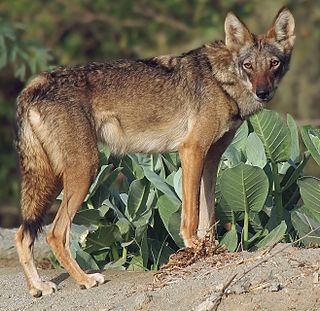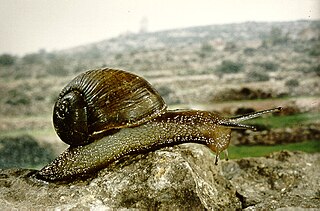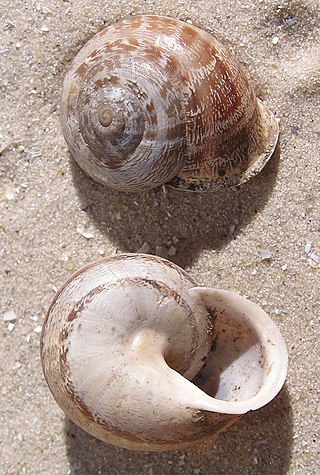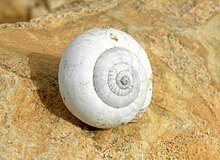
Aestivation is a state of animal dormancy, similar to hibernation, although taking place in the summer rather than the winter. Aestivation is characterized by inactivity and a lowered metabolic rate, that is entered in response to high temperatures and arid conditions. It takes place during times of heat and dryness, which are often the summer months.

Euchondrus is a genus of very small air-breathing land snails, terrestrial pulmonate gastropod mollusks in the family Enidae.

The Arabian wolf is a subspecies of gray wolf native to the Arabian Peninsula—to the west of Bahrain, as well as Oman, southern Saudi Arabia, and Yemen. They are also found in Israel’s Negev and Arava Deserts, Jordan, Palestine, and Egypt's Sinai Peninsula. It is the smallest Gray wolf subspecies, and a specialized xerocole (arid-adapted) animal that normally lives in smaller familial packs. Arabian wolves are omnivorous and opportunistic eaters; they consume small to medium-sized prey, from insects, reptiles and birds to rodents and small ungulates, such as young Nubian ibex and several species of gazelle.

Terrestrial animals are animals that live predominantly or entirely on land, as compared with aquatic animals, which live predominantly or entirely in the water, and semiaquatic animals, which rely on both aquatic and terrestrial habitats. Some groups of insects are terrestrial, such as ants, butterflies, earwigs, cockroaches, grasshoppers and many others, while other groups are partially aquatic, such as mosquitoes and dragonflies, which pass their larval stages in water.

An epiphragm is a temporary structure which can be created by many species of shelled, air-breathing land snails, terrestrial pulmonate gastropod mollusks. It can also be created by freshwater snails when temporary pools dry up.

Cantareus apertus, commonly known as the green garden snail, is a species of air-breathing land snail, a terrestrial pulmonate gastropod mollusc in the family Helicidae, the typical snails.

A land snail is any of the numerous species of snail that live on land, as opposed to the sea snails and freshwater snails. Land snail is the common name for terrestrial gastropod mollusks that have shells. However, it is not always easy to say which species are terrestrial, because some are more or less amphibious between land and fresh water, and others are relatively amphibious between land and salt water.

Theba pisana, common names the white garden snail, sand hill snail, white Italian snail, Mediterranean coastal snail, and simply just the Mediterranean snail, is an edible species of medium-sized, air-breathing land snail, a terrestrial pulmonate gastropod mollusk in the family Helicidae, the typical snails.

Eobania vermiculata also known as Helix vermiculata, common name the "chocolate-band snail" is a species of large, air-breathing, land snail, a terrestrial pulmonate gastropod mollusk in the family Helicidae, the true snails or typical snails.

Sphincterochila is a genus of air-breathing land snails, terrestrial pulmonate gastropod molluscs in the family Sphincterochilidae.

Sphincterochila prophetarum is a species of air-breathing land snail, a terrestrial pulmonate gastropod mollusk in the family Sphincterochilidae.

Xerocrassa seetzeni is a species of air-breathing land snail, a terrestrial pulmonate gastropod mollusk in the family Geomitridae.

Xerocrassa simulata is a species of air-breathing land snail, a terrestrial pulmonate gastropod mollusk in the family Geomitridae. It is endemic to southern Spain, specifically adapted to dry Mediterranean climates. Like other land snails, it undergoes a life cycle that includes egg laying, hatching of juveniles, shell development, and reproductive maturity as adults. These snails play a crucial role in their ecosystem by recycling nutrients and serving as prey for various predators, highlighting their ecological significance in their native habitat.

Hemilepistus reaumuri is a species of woodlouse that lives in and around the deserts of North Africa and the Middle East, "the driest habitat conquered by any species of crustacean, not including insects which are now known to be crustaceans pancrustacea". It reaches a length of 22 mm (0.87 in) and a width of up to 12 mm (0.47 in), and has seven pairs of legs which hold its body unusually high off the ground. The species was described in the Description de l'Égypte after the French Campaign in Egypt and Syria of 1798–1801, but was first formally named by Henri Milne-Edwards in 1840 as Porcellio reaumuri. It reached its current scientific name in 1930 after the former subgenus Hemilepistus was raised to the rank of genus.
Moshe Shachak is an ecologist at the Ben Gurion University. Shachak’s research focuses on ecosystem engineers, organisms that modulate the abiotic environment. Most of his studies were conducted in arid and semi arid ecosystems.
Cathaica fasciola is a species of air-breathing land snail, a terrestrial pulmonate gastropod mollusk in the family Camaenidae, which is similar to Cathaica pyrrhozona on shell morphology.
Sphincterochila zonata is a species of air-breathing land snail, a terrestrial pulmonate gastropod mollusk in the family Sphincterochilidae.
















